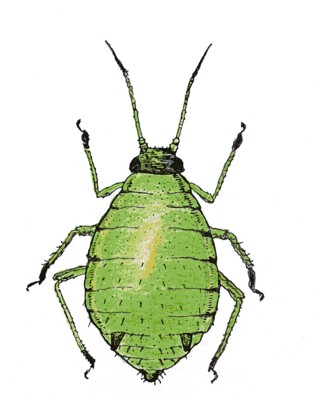Pests
Brachycaudus helichrysi Kalt. - Leafcurl Plum Aphid
Systematic position.
Class Insecta, order Homoptera, suborder Aphidinea, superfamily Aphidoidea, family Aphididae, subfamily Aphidinae, tribe Macrosiphini, subtribe Anuraphidina, genus Brachycaudus.Synonyms.
Brachycaudus pruniavium Nev., B. transchanicus Nevs., Aphis helichrysi Kalt., A. myosotidis Koch.Biological group.
Oligophagous pest of stone fruit trees and sunflowers.Morphology and biology.
Pear-shaped body of apterous female is yellow-green. Its length varies from 1.5 to 2.0 mm. The insect has no visible marginal tubercles, but sometimes has 2 medial tubercles on 8th or both 7th and 8th segments of abdomen. Light 6-segmented antenna (with dark last segment) is half as long as body. There are no tubercles and flutes on flat frons. Covers are located on short, conic, dark-green siphunculi. The species has light, very short tail (as wide as long). Legs are light; but apices of femora, tarsi, and tibiae are dark. Body of winged female reaches to 1.3-1.8 mm. Its head and thorax are dark; but its abdomen is green, with a dark spot on 3rd-6th segments. Round dark spots are also located on segments laterally. Dark antenna is 3/4 the body length. The aphid has dark visible tubercle on frons. Cylindrical siphunculi are dark, with covers. Oval eggs are black. Overwintering takes place at the phase of egg. Eggs are located at bud base on young shoots of stone fruit trees. Hatching of fundatrix larvae in the zone of strong harmfulness is observed at the end of March or in April (at the beginning of bud swelling in plum). The species feeds on plum, wild plum, peach, apricot, almond trees. The insects prefer lower side of upper leaves, forming large colonies. They also feed on flower. The aphids suck sap from leaf veins. The species is a typical migrant; its secondary hosts are usually plants of the family Compositae. Beginning of migration takes place at the end of May; maximal activity is marked in the second half of June. The biggest number of insects is observed in the first half of June, then decreasing considerably. Larval period lasts 6-11 days. Life span of apterous parthenogenetic females is about 24-49 days (depending on generation and meteorological conditions); their fecundity varies from 40 to 110 larvae. The Leafcurl Plum Aphid forms big colonies on both primary and secondary hosts. In August-September the insects migrate to primary hosts; then viginoparae appear, giving the sexual generation. Oviposition takes place from October until strong frosts. Females lay eggs at bud base by 2-5.Distribution.
The species is spread in Europe; Anterior and Middle Asia; North America, North Africa, Australia. Within the territory of the Former USSR, the species occurs widely in the zone of hosts. growing. Its highest harmful activity is recorded in the Crimea, Middle Asia, Kazakhstan (in southern regions mainly), in the North Caucasus, Transcaucasia.Ecology.
Hatching of fundatrix larvae is observed at the daily temperatures 12-14°C at lower developmental threshold 5-6°C. The most favorable conditions for apterous female are the temperature 22-26°C and relative humidity 70-80%. The pest gives 10-16 generations a year. Most important predators are Synharmonia conglobata L., Scymnus subvillosus Qz., Adalia bipunctata L., Propylaea 14-punctata L., Coccinella septempunctata L., C. quinquepunctata L., Adonia variegata Goeze., Chrysopa. perla L., Ch. carnea Steph., Ch. albolineata Kill., Cr. matynovae Lup., Syrphus corollae F., S. balteatus Deg., S. ribesii L., S. interrumpes Walk., Paragus aegiptius Wd., Ephedrus persicae Frogg., E. plagiator N, E. cerasicola Stary, Praon volucre Hal., Praon volucre Hal., Leucopis atrifarsis Tanas., L. glyphinivora Tanas.Economic significance.
The species is oligophagous. It damages stone fruit trees, such as plum, apricot, wild plum, almond and peach, also sunflower and flowers; e.g, aster and chrysanthemum. The Leafcurl Plum Aphid feeds on Achillea millefolium L., Tripleurospermum inodorum L., Anchusa barrelier All., Erigeron annulus L., Anthemis subtinctoria Dobrocz., Pyrethrum corymbosum L., Artemisia vulgaris L. Damaged leaves become yellow along veins; diametrical wrinkles are formed on their surface. The leaves bend, roll, and dry up. Flowers dry up also, fruits fall down, trees weaken. Fruit losses increase considerably. The Leafcurl Plum Aphid transfers dangerous diseases. Control measures include eradication of weeds, insecticide treatments of fruits (primarily plum) in April-June.Reference citations:
Andreev A.V. 1982. Aphids of plum gardens in Moldova. PHD Thesis. Kishinev: Institute of Zoology and Physiology. 22 p. (in Russian).Ivanovskaya O.I. 1976. Fauna of aphids on the territory of West Siberia. In: Zolotorenko G.S., ed. Fauna of helminthes and arthropods of Siberia. Novosibirsk: Nauka. P. 175-189 (in Russian).
Ivanovskaya, O.I. & Kupyanskaya, A.N. 1979. Aphids (Homoptera, Aphididae) damaging trees and bushes in Primorskii Territory. In: Ivliev L.A., ed. Ecology and biology of arthropods in the southern Far East. Vladivostok: AN SSSR. 36-51 p. (in Russian).
Kolesova D.A. 1976. Leafcurl plum aphid. Zashchita rastenii 11: 46-47 (in Russian).
Kolomiets T.P., Zhivilo V.I. & Voskoboinikov V.V. 1975. Leafcurl plum aphid on aster. Zashchita rastenii 12: 41-42 (in Russian).
Nevskii V.P. 1929. Aphids of Middle Asia. Proceedings of Uzbekistan Experimental plant protection station 16. Tashkent. 275-278 p. (in Russian).
Shaposhnikov G.Kh. 1964. Order Homoptera - homopterous. In: Kryzhanovskii O.L., ed. Insects and mites - pests of agricultural crops. V. 1. Leningrad: Nauka. P. 587 (in Russian).
Vasil.ev V.P., ed. 1973. Pests of agricultural crops and forest plantations. V. 1. Kiev: Urozhai. 295-296 p. (in Russian).
Vereshchagin B.V. & Andreev A.V. 1981. Aphids (Homoptera, Aphidoidea) damaging plum in Moldova. In: Lupashku M.F., ed. Proceedings of AN Moldavian SSR. N 5. Kishinev: Shtiintsa. 36-41 p. (in Russian).
Vereshchagina V.V. & Vereshchagin B.V. 1966. Aphids on stone fruit trees in Moldova and their diagnostics. In: Talitskii V.I., ed. Proceedings of Moldavian Institute of gardening, viniculture and wine making. V. 13. Kishinev: Kartya Moldovenyaske. 39-52 p. (in Russian).


